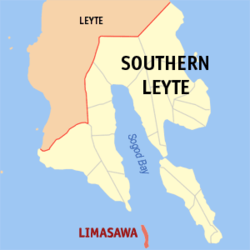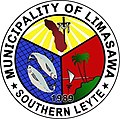Limasawa Mazaua | |
|---|---|
| Municipality of Limasawa | |
 Sea in the island | |
| Nickname: "The First Mass Site in the Philippines" | |
| Motto: Ang hindi marunong magmahal sa sariling wika ay higit pa sa hayop at malansang isda. | |
 Map of Southern Leyte with Limasawa highlighted | |
Location within the Philippines | |
| Coordinates: 9°54′28″N125°04′30″E / 9.9078°N 125.075°E | |
| Country | Philippines |
| Region | Eastern Visayas |
| Province | Southern Leyte |
| District | 1st district |
| Founded | June 11, 1978 (Completely became official on August 27, 1989) |
| Barangays | 6 (see Barangays) |
| Government | |
| • Type | Sangguniang Bayan |
| • Mayor | Melchor P. Petracorta (Lakas) |
| • Vice Mayor | Ritche L. Salomon (Lakas) |
| • Representative | Luz V. Mercado |
| • Municipal Council | Members |
| • Electorate | 4,436 voters (2025) |
| Area | |
• Total | 6.98 km2 (2.69 sq mi) |
| Elevation | 13 m (43 ft) |
| Highest elevation | 848 m (2,782 ft) |
| Lowest elevation | 0 m (0 ft) |
| Population (2024 census) [3] | |
• Total | 7,118 |
| • Density | 1,020/km2 (2,640/sq mi) |
| • Households | 1,491 |
| Demonym | Limasawan |
| Economy | |
| • Income class | 6th municipal income class |
| • Poverty incidence | 27.02 |
| • Revenue | ₱ 85.11 million (2022) |
| • Assets | ₱ 319.8 million (2022) |
| • Expenditure | ₱ 81.69 million (2022) |
| • Liabilities | ₱ 120.2 million (2022) |
| Service provider | |
| • Electricity | Southern Leyte Electric Cooperative (SOLECO) |
| Time zone | UTC+8 (PST) |
| ZIP code | 6605 |
| PSGC | |
| IDD : area code | +63 (0)53 |
| Native languages | Boholano dialect Cebuano Tagalog |
Limasawa, officially the Municipality of Limasawa (Cebuano: Lungsod sa Limasawa; Filipino: Bayan ng Limasawa), is an island municipality in the province of Southern Leyte, Philippines. According to the 2020 census, it has a population of 6,191 people, making it the least populated town in the province. [5]



